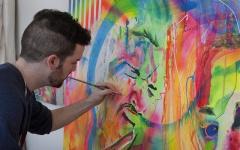Employers and Universities: Work with us?

Applying To Art School: All You Need To Know About Art Portfolios
Think you could be the next Picasso, Yves Saint Laurent or Antoni Gaudi? In that case, you’ve probably been thinking about applying to an arts or design course. These courses can improve your creative skills and set you on the path to turning your art into a profession.
But unlike your run-of-the-mill university degree, these art and design courses often require you to do something a little different with your application. From Architecture to Fashion, you’re going to have to get creative and create….a portfolio for art school.
We caught up with fashion design student and blogger, Jessica Margo, to find out what goes into the process of making a portfolio for art school and applying to an arts course.
What is an Art Portfolio?
An art portfolio is a carefully selected collection of artwork that showcases your creative skills, interests and ideas. In a way, it’s kind of like the personal statement for your creativity. It gives colleges and universities the chance to see your artwork in person and get an idea of how you work. It’s your way to show off your personality and any potential you might have as an artist. “It’s basically the way you sell yourself as a brand”, says Jess.
'Treat your art college portfolio as an opportunity to showcase your brand'
What Should an Art Portfolio Contain?
Every course has different requirements which means there is no “one size fits all”. But at its core, your portfolio for art school should include some of your final pieces and any research that shows the development of your ideas. This can be anything from drawings, notes, textiles, digital media, and even sculptures. And these don’t have to be things you’ve created at school. As Jess points out; “90% of my portfolio for art school was extra work or expansions on things within my sketchbook”.
Jess also says not to be afraid to include the ‘bad’ stuff, either, as this shows you have room to improve: “Art portfolios [should] show you in the best light whilst also giving examples of areas you’re not strong at”.
Remember, some universities require different things to be included. So make sure to read the application guidelines before you make your submission.
Check out this video by artist Chesa Djanelle on how to put together a really impressive portfolio:
What do Universities Look for in an Art Portfolio?
One of the biggest things that universities look for in a portfolio is creativity. If you think you’re not the most talented designer or artist - don’t worry! “They aren’t bothered if you can’t draw the best, whether or not you can sew, or if you can use photoshop”, says Jess, “they care more about how your brain works, in a creative way.” With that in mind, a good art portfolio successfully captures the personality of an artist and how they work. Universities want to see if you can develop an idea from start to finish while remaining committed to a specific theme.
Watch this video from Birmingham City University which gives you an idea of what college's might be expecting from your portfolio:
Will I Have to Attend an Interview for Art School?
This depends on the course you’re applying for but for the most part the answer is “Yes”. The aim of the interview is to discuss your portfolio in person and see how committed you are to your craft. “My interview was formal but friendly”, adds Jess. “They asked me the usual questions such as ‘Why do you want to study Fashion?’ but they also asked me who my favourite artists and designers were”.
When in doubt, sit down and discuss the course and your art portfolio with a friend or family member. Encourage them to ask any questions they have about your artwork. This will give you some confidence and get you prepared for the big day!
Anything else?
Yep! Jess has some words of wisdom: “Make sure [an arts course] is 100% the right path for you. A lot of people assume that fashion and art courses are easy and are for people who ‘don’t know what they want to do’. When in actual fact, it’s for people who are dead set to make it into the industry. If you're very keen to apply, make sure you put in the work at GCSE level to develop your skills because it will give you a bigger advantage when you come to apply to university.”
Subscribe to Jessica’s youtube channel and blog for fashion advice and more tips on how to apply to arts and fashion courses. Take a look at her top tips on how to make a great art portfolio here.
Not sure if a career in Art or Fashion is for you? Check out our Art & Design and Fashion & Beauty career zones to learn more.
Related Articles:
How To Write A Personal Statement
